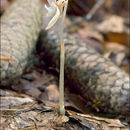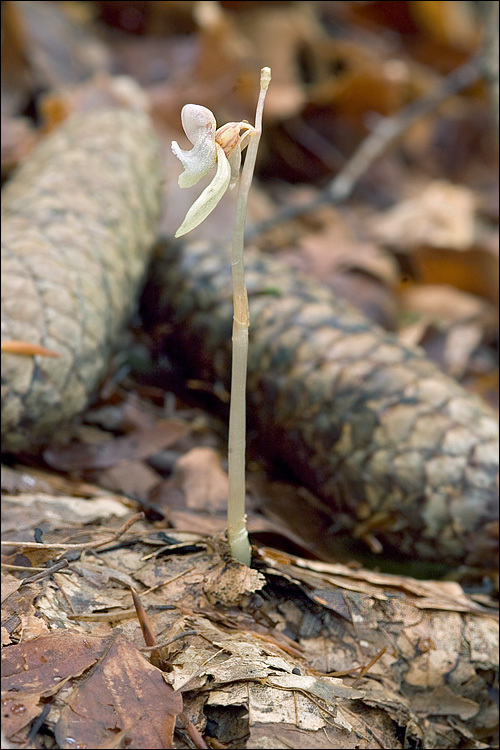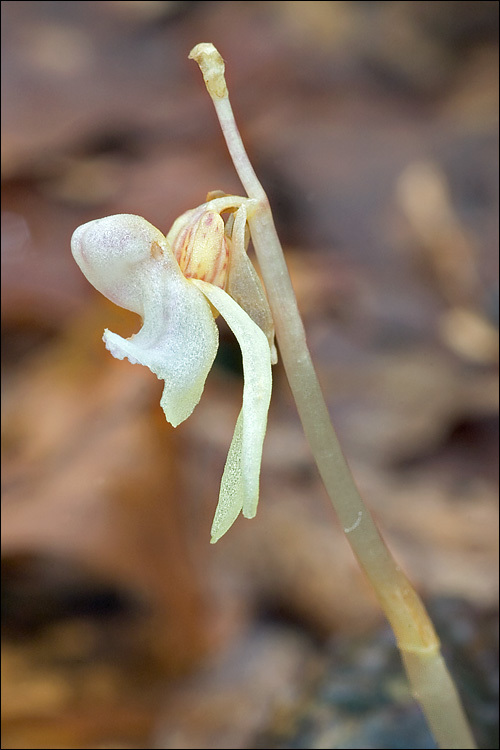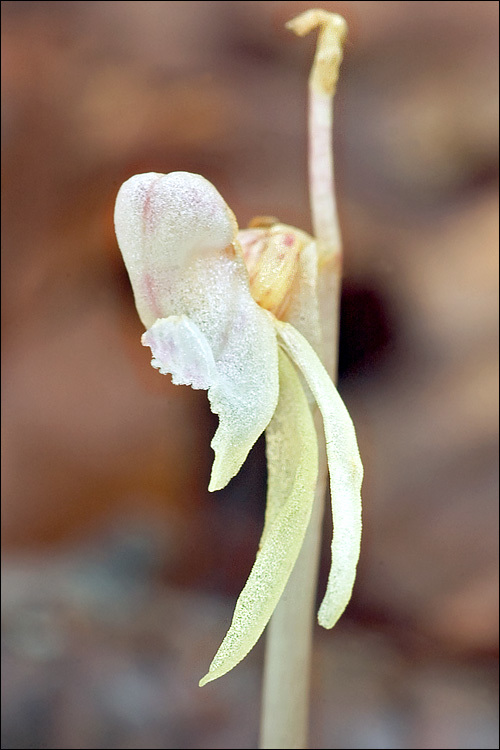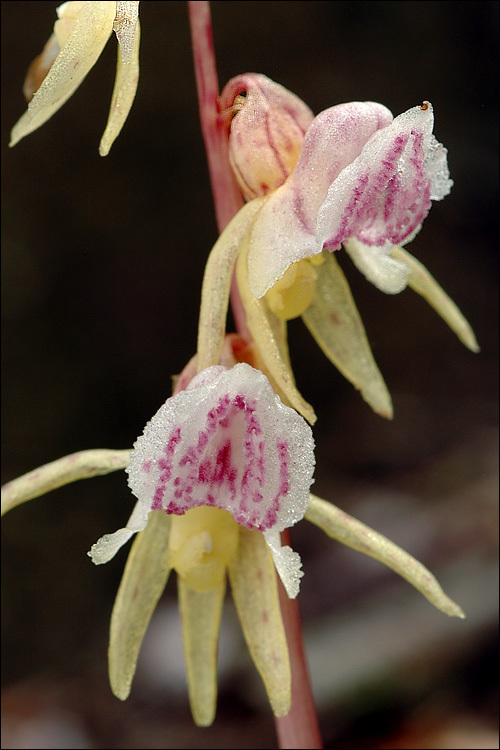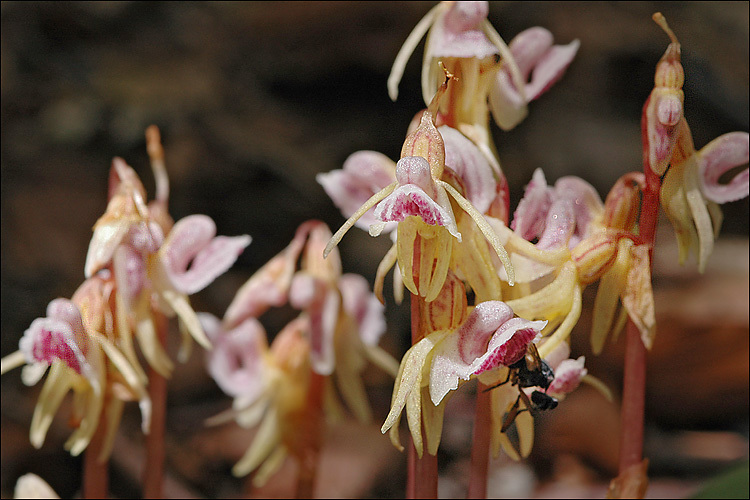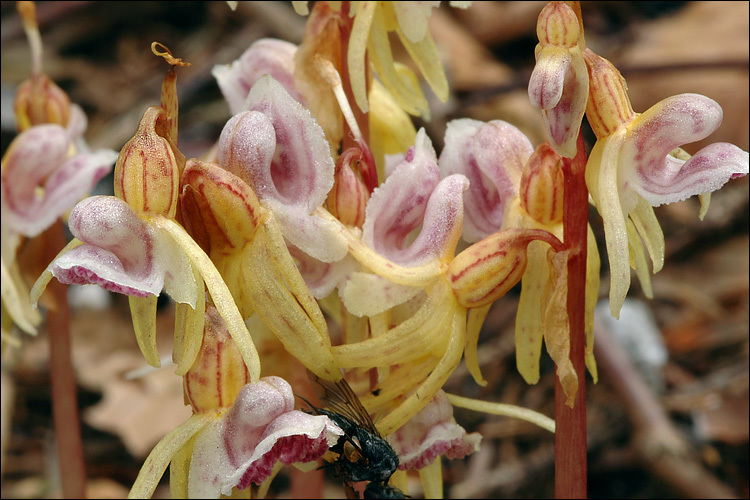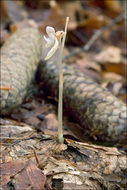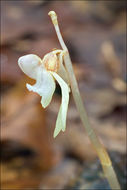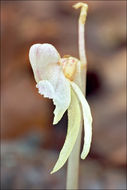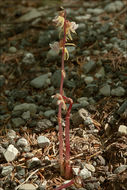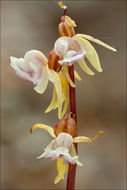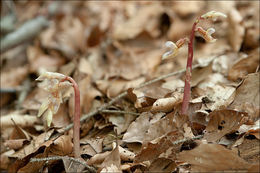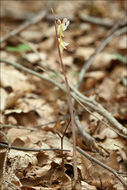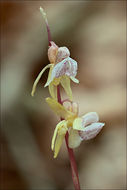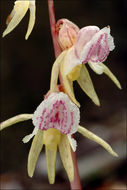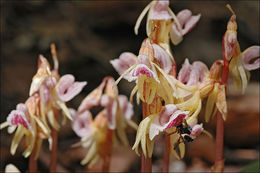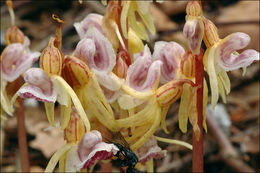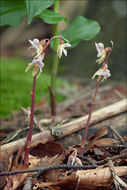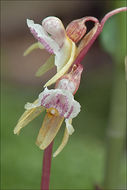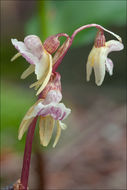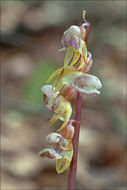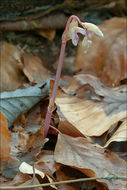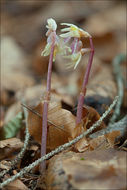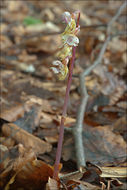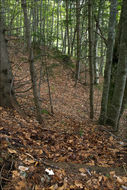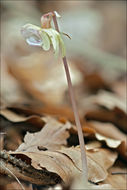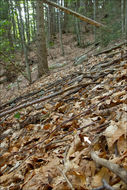-
Slo.: brezlistni nadbradec - Enlisted in the Slovene Red List of rare and endangered species, marked by 'V' representing a vulnerable species. Extremely rare. Coordinates not precise.
-
Slo.: brezlistni nadbradec - Enlisted in the Slovene Red List of rare and endangered species, marked by 'V' representing a vulnerable species. Extremely rare. Coordinates not precise.
-
Slo.: brezlistni nadbradec - Enlisted in the Slovene Red List of rare and endangered species, marked by 'V' representing a vulnerable species. Extremely rare. Coordinates not precise.
-
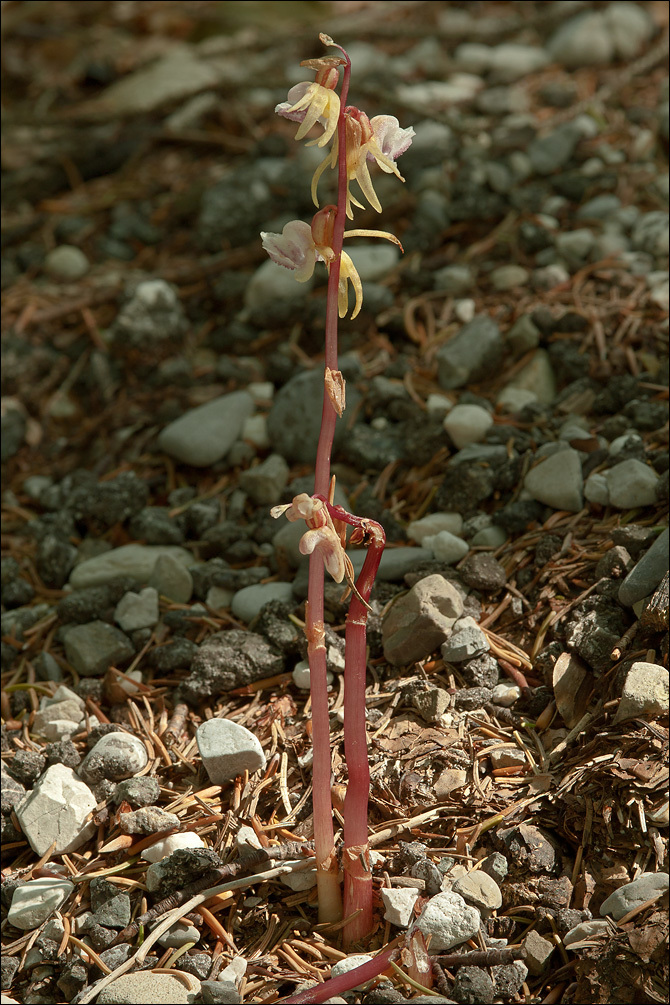
Slo.: brezlistni nadbradec - syn.: Satyrium epipogium L - Habitat: steep mixed beech/spruce woods, regularly under beeches, south to southwest oriented mountain slope, in deep shade, calcareous ground, on places with little or no ground vegetation, partly protected from direct rain, average precipitations ~3.000 mm/year, average temperature 2-4 deg C, elevation approximately 1.200 m (4.000 feet), alpine phytogeographical region. - Substratum: soil. - Comments: Finally! After four years again in bloom! This, probably the most rare and mysterious, mostly underground growing orchid of Slovenia and probably of Europe too, appears only every few years. The last time I saw these leaf and chlorophyll-less, 'parasitic' plants (achlorophyllous, mycoheterotrophic plant) in flowers at these two places was in 2008 and then in 2011. I have checked the places every year and have found nothing. Of cause, it is always possible that I overlooked them, but they also haven't been seen by others. This year (2015) we have an 'orchids year' in Posoje region. Several species appeared in large numbers on most uncommon places, some massively. I suspected that Epipogium aphyllum will behave similarly and it really did. Six plants have been found altogether. May be that extremely wet summer in 2014 favorably influenced growth of underground fungi (mostly Inocybe species), which are so important for growth of orchids (Ref.:1)? - Protected by Uredba o zavarovanih prosto iveih rastlinskih vrstah, poglavje A, Uradni list RS, t. 46/2004 (Regulation of protected wild plants, chapter A, Official Gazette of Republic Slovenia, no. 46/2004), (2004). Pravilnik o uvrstitvi ogroenih rastlinskih in ivalskih vrst v rdei seznam, Uradni list RS, t. 82/2002 (Regulation of enlisting of endangered plant and animal species onto Red List, Official Gazette of Republic Slovenia, no. 82/2002) (2002) marked by 'V' representing a vulnerable species. - Ref.: (1) http://www.ncbi.nlm.nih.gov/pmc/articles/PMC2720653/ (2) B.Dolinar, Kukavievke v Sloveniji (Orchidaceae of Slovenia) (in Slovenian), Pipinova Knjiga, (2015), p85. (3) A.Martini et all., Mala Flora Slovenije, Tehnina Zaloba Slovenije (2007) (in Slovene), p 668.
-
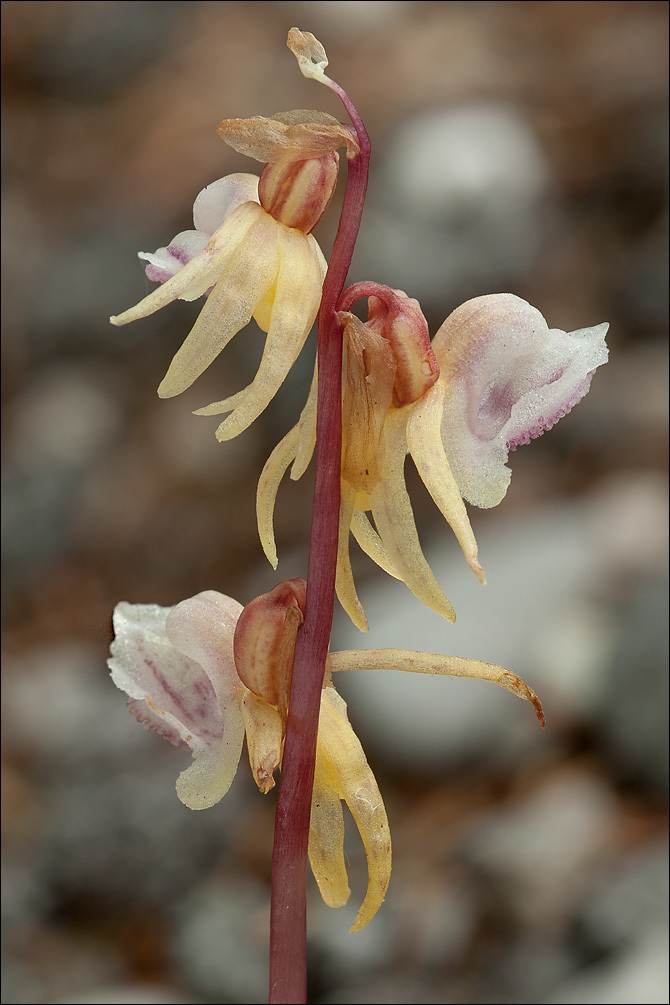
Slo.: brezlistni nadbradec - syn.: Satyrium epipogium L - Habitat: steep mixed beech/spruce woods, regularly under beeches, south to southwest oriented mountain slope, in deep shade, calcareous ground, on places with little or no ground vegetation, partly protected from direct rain, average precipitations ~3.000 mm/year, average temperature 2-4 deg C, elevation approximately 1.200 m (4.000 feet), alpine phytogeographical region. - Substratum: soil. - Comments: Finally! After four years again in bloom! This, probably the most rare and mysterious, mostly underground growing orchid of Slovenia and probably of Europe too, appears only every few years. The last time I saw these leaf and chlorophyll-less, 'parasitic' plants (achlorophyllous, mycoheterotrophic plant) in flowers at these two places was in 2008 and then in 2011. I have checked the places every year and have found nothing. Of cause, it is always possible that I overlooked them, but they also haven't been seen by others. This year (2015) we have an 'orchids year' in Posoje region. Several species appeared in large numbers on most uncommon places, some massively. I suspected that Epipogium aphyllum will behave similarly and it really did. Six plants have been found altogether. May be that extremely wet summer in 2014 favorably influenced growth of underground fungi (mostly Inocybe species), which are so important for growth of orchids (Ref.:1)? - Protected by Uredba o zavarovanih prosto iveih rastlinskih vrstah, poglavje A, Uradni list RS, t. 46/2004 (Regulation of protected wild plants, chapter A, Official Gazette of Republic Slovenia, no. 46/2004), (2004). Pravilnik o uvrstitvi ogroenih rastlinskih in ivalskih vrst v rdei seznam, Uradni list RS, t. 82/2002 (Regulation of enlisting of endangered plant and animal species onto Red List, Official Gazette of Republic Slovenia, no. 82/2002) (2002) marked by 'V' representing a vulnerable species. - Ref.: (1) http://www.ncbi.nlm.nih.gov/pmc/articles/PMC2720653/ (2) B.Dolinar, Kukavievke v Sloveniji (Orchidaceae of Slovenia) (in Slovenian), Pipinova Knjiga, (2015), p85. (3) A.Martini et all., Mala Flora Slovenije, Tehnina Zaloba Slovenije (2007) (in Slovene), p 668.
-
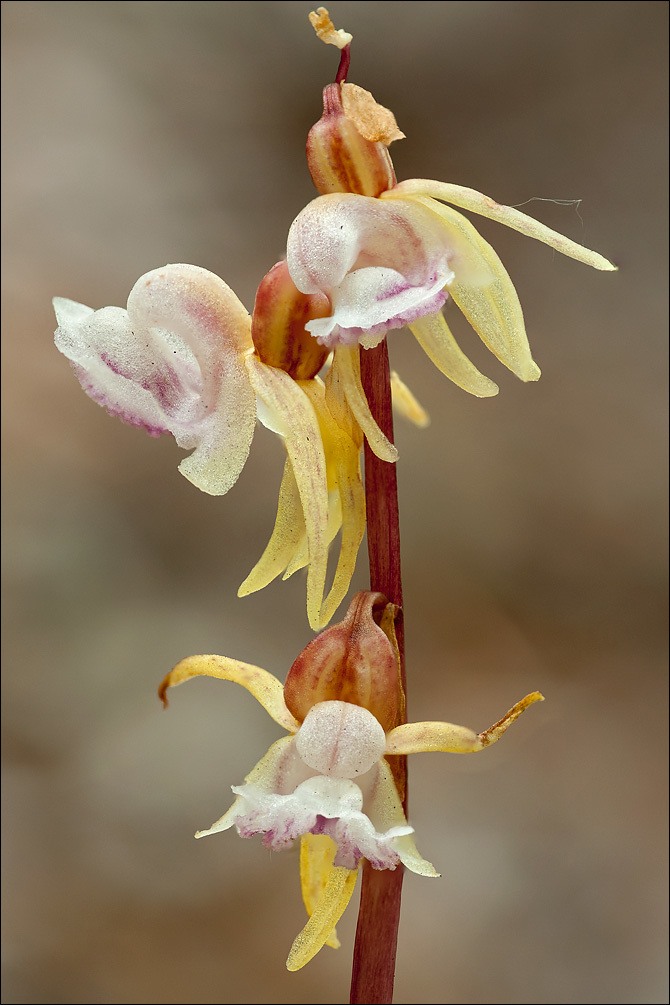
Slo.: brezlistni nadbradec - syn.: Satyrium epipogium L - Habitat: steep mixed beech/spruce woods, regularly under beeches, south to southwest oriented mountain slope, in deep shade, calcareous ground, on places with little or no ground vegetation, partly protected from direct rain, average precipitations ~3.000 mm/year, average temperature 2-4 deg C, elevation approximately 1.200 m (4.000 feet), alpine phytogeographical region. - Substratum: soil. - Comments: Finally! After four years again in bloom! This, probably the most rare and mysterious, mostly underground growing orchid of Slovenia and probably of Europe too, appears only every few years. The last time I saw these leaf and chlorophyll-less, 'parasitic' plants (achlorophyllous, mycoheterotrophic plant) in flowers at these two places was in 2008 and then in 2011. I have checked the places every year and have found nothing. Of cause, it is always possible that I overlooked them, but they also haven't been seen by others. This year (2015) we have an 'orchids year' in Posoje region. Several species appeared in large numbers on most uncommon places, some massively. I suspected that Epipogium aphyllum will behave similarly and it really did. Six plants have been found altogether. May be that extremely wet summer in 2014 favorably influenced growth of underground fungi (mostly Inocybe species), which are so important for growth of orchids (Ref.:1)? - Protected by Uredba o zavarovanih prosto iveih rastlinskih vrstah, poglavje A, Uradni list RS, t. 46/2004 (Regulation of protected wild plants, chapter A, Official Gazette of Republic Slovenia, no. 46/2004), (2004). Pravilnik o uvrstitvi ogroenih rastlinskih in ivalskih vrst v rdei seznam, Uradni list RS, t. 82/2002 (Regulation of enlisting of endangered plant and animal species onto Red List, Official Gazette of Republic Slovenia, no. 82/2002) (2002) marked by 'V' representing a vulnerable species. - Ref.: (1) http://www.ncbi.nlm.nih.gov/pmc/articles/PMC2720653/ (2) B.Dolinar, Kukavievke v Sloveniji (Orchidaceae of Slovenia) (in Slovenian), Pipinova Knjiga, (2015), p85. (3) A.Martini et all., Mala Flora Slovenije, Tehnina Zaloba Slovenije (2007) (in Slovene), p 668.
-
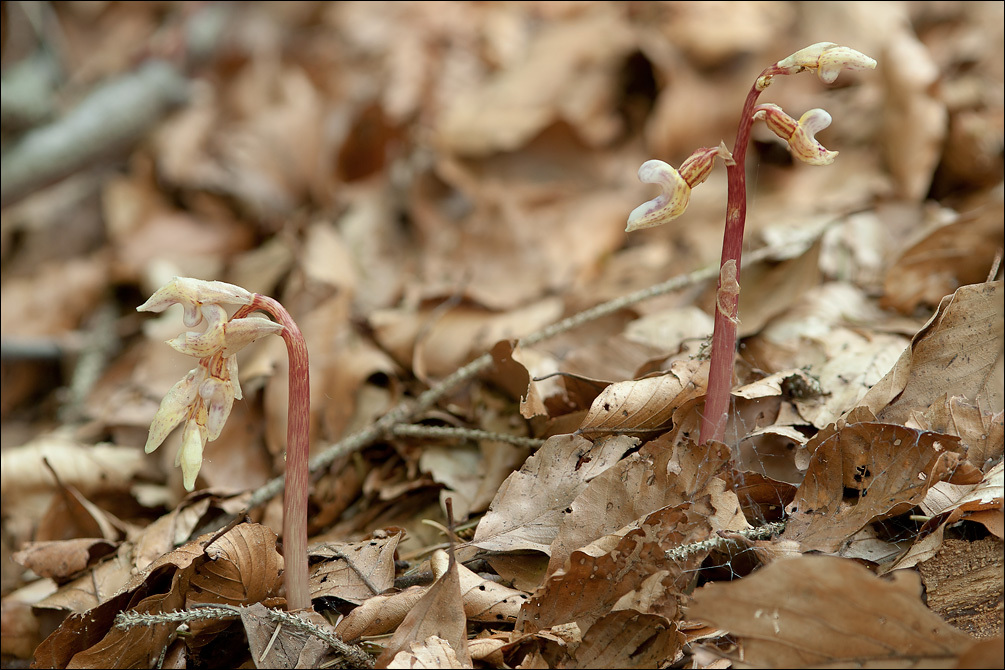
Slo.: brezlistni nadbradec - syn.: Satyrium epipogium L - Habitat: steep mixed beech/spruce woods, regularly under beeches, south to southwest oriented mountain slope, in deep shade, calcareous ground, on places with little or no ground vegetation, partly protected from direct rain, average precipitations ~3.000 mm/year, average temperature 2-4 deg C, elevation approximately 1.200 m (4.000 feet), alpine phytogeographical region. - Substratum: soil. - Comments: Finally! After four years again in bloom! This, probably the most rare and mysterious, mostly underground growing orchid of Slovenia and probably of Europe too, appears only every few years. The last time I saw these leaf and chlorophyll-less, 'parasitic' plants (achlorophyllous, mycoheterotrophic plant) in flowers at these two places was in 2008 and then in 2011. I have checked the places every year and have found nothing. Of cause, it is always possible that I overlooked them, but they also haven't been seen by others. This year (2015) we have an 'orchids year' in Posoje region. Several species appeared in large numbers on most uncommon places, some massively. I suspected that Epipogium aphyllum will behave similarly and it really did. Six plants have been found altogether. May be that extremely wet summer in 2014 favorably influenced growth of underground fungi (mostly Inocybe species), which are so important for growth of orchids (Ref.:1)? - Protected by Uredba o zavarovanih prosto iveih rastlinskih vrstah, poglavje A, Uradni list RS, t. 46/2004 (Regulation of protected wild plants, chapter A, Official Gazette of Republic Slovenia, no. 46/2004), (2004). Pravilnik o uvrstitvi ogroenih rastlinskih in ivalskih vrst v rdei seznam, Uradni list RS, t. 82/2002 (Regulation of enlisting of endangered plant and animal species onto Red List, Official Gazette of Republic Slovenia, no. 82/2002) (2002) marked by 'V' representing a vulnerable species. - Ref.: (1) http://www.ncbi.nlm.nih.gov/pmc/articles/PMC2720653/ (2) B.Dolinar, Kukavievke v Sloveniji (Orchidaceae of Slovenia) (in Slovenian), Pipinova Knjiga, (2015), p85. (3) A.Martini et all., Mala Flora Slovenije, Tehnina Zaloba Slovenije (2007) (in Slovene), p 668.
-

Slo.: brezlistni nadbradec - syn.: Satyrium epipogium L - Habitat: steep mixed beech/spruce woods, regularly under beeches, south to southwest oriented mountain slope, in deep shade, calcareous ground, on places with little or no ground vegetation, partly protected from direct rain, average precipitations ~3.000 mm/year, average temperature 2-4 deg C, elevation approximately 1.200 m (4.000 feet), alpine phytogeographical region. - Substratum: soil. - Comments: Finally! After four years again in bloom! This, probably the most rare and mysterious, mostly underground growing orchid of Slovenia and probably of Europe too, appears only every few years. The last time I saw these leaf and chlorophyll-less, 'parasitic' plants (achlorophyllous, mycoheterotrophic plant) in flowers at these two places was in 2008 and then in 2011. I have checked the places every year and have found nothing. Of cause, it is always possible that I overlooked them, but they also haven't been seen by others. This year (2015) we have an 'orchids year' in Posoje region. Several species appeared in large numbers on most uncommon places, some massively. I suspected that Epipogium aphyllum will behave similarly and it really did. Six plants have been found altogether. May be that extremely wet summer in 2014 favorably influenced growth of underground fungi (mostly Inocybe species), which are so important for growth of orchids (Ref.:1)? - Protected by Uredba o zavarovanih prosto iveih rastlinskih vrstah, poglavje A, Uradni list RS, t. 46/2004 (Regulation of protected wild plants, chapter A, Official Gazette of Republic Slovenia, no. 46/2004), (2004). Pravilnik o uvrstitvi ogroenih rastlinskih in ivalskih vrst v rdei seznam, Uradni list RS, t. 82/2002 (Regulation of enlisting of endangered plant and animal species onto Red List, Official Gazette of Republic Slovenia, no. 82/2002) (2002) marked by 'V' representing a vulnerable species. - Ref.: (1) http://www.ncbi.nlm.nih.gov/pmc/articles/PMC2720653/ (2) B.Dolinar, Kukavievke v Sloveniji (Orchidaceae of Slovenia) (in Slovenian), Pipinova Knjiga, (2015), p85. (3) A.Martini et all., Mala Flora Slovenije, Tehnina Zaloba Slovenije (2007) (in Slovene), p 668.
-
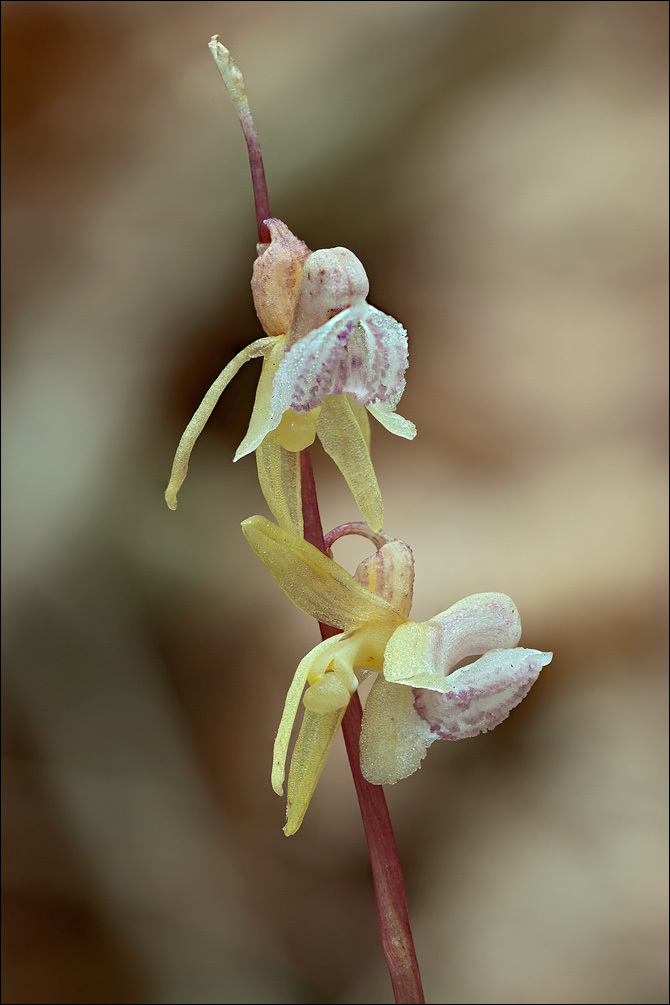
Slo.: brezlistni nadbradec - syn.: Satyrium epipogium L - Habitat: steep mixed beech/spruce woods, regularly under beeches, south to southwest oriented mountain slope, in deep shade, calcareous ground, on places with little or no ground vegetation, partly protected from direct rain, average precipitations ~3.000 mm/year, average temperature 2-4 deg C, elevation approximately 1.200 m (4.000 feet), alpine phytogeographical region. - Substratum: soil. - Comments: Finally! After four years again in bloom! This, probably the most rare and mysterious, mostly underground growing orchid of Slovenia and probably of Europe too, appears only every few years. The last time I saw these leaf and chlorophyll-less, 'parasitic' plants (achlorophyllous, mycoheterotrophic plant) in flowers at these two places was in 2008 and then in 2011. I have checked the places every year and have found nothing. Of cause, it is always possible that I overlooked them, but they also haven't been seen by others. This year (2015) we have an 'orchids year' in Posoje region. Several species appeared in large numbers on most uncommon places, some massively. I suspected that Epipogium aphyllum will behave similarly and it really did. Six plants have been found altogether. May be that extremely wet summer in 2014 favorably influenced growth of underground fungi (mostly Inocybe species), which are so important for growth of orchids (Ref.:1)? - Protected by Uredba o zavarovanih prosto iveih rastlinskih vrstah, poglavje A, Uradni list RS, t. 46/2004 (Regulation of protected wild plants, chapter A, Official Gazette of Republic Slovenia, no. 46/2004), (2004). Pravilnik o uvrstitvi ogroenih rastlinskih in ivalskih vrst v rdei seznam, Uradni list RS, t. 82/2002 (Regulation of enlisting of endangered plant and animal species onto Red List, Official Gazette of Republic Slovenia, no. 82/2002) (2002) marked by 'V' representing a vulnerable species. - Ref.: (1) http://www.ncbi.nlm.nih.gov/pmc/articles/PMC2720653/ (2) B.Dolinar, Kukavievke v Sloveniji (Orchidaceae of Slovenia) (in Slovenian), Pipinova Knjiga, (2015), p85. (3) A.Martini et all., Mala Flora Slovenije, Tehnina Zaloba Slovenije (2007) (in Slovene), p 668.
-
Slo.: brezlistni nadbradec - Enlisted in the Slovene Red List of rare and endangered species, marked by 'V' representing a vulnerable species. Extremely rare. Coordinates not precise.
-
Slo.: brezlistni nadbradec - Enlisted in the Slovene Red List of rare and endangered species, marked by 'V' representing a vulnerable species. Extremely rare. Coordinates not precise.
-
Slo.: brezlistni nadbradec - Enlisted in the Slovene Red List of rare and endangered species, marked by 'V' representing a vulnerable species. Extremely rare. Coordinates not precise.
-
Slo.: brezlistni nadbradec - Enlisted in the Slovene Red List of rare and endangered species, marked by 'V' representing a vulnerable species. Extremely rare. Coordinates not precise.
-
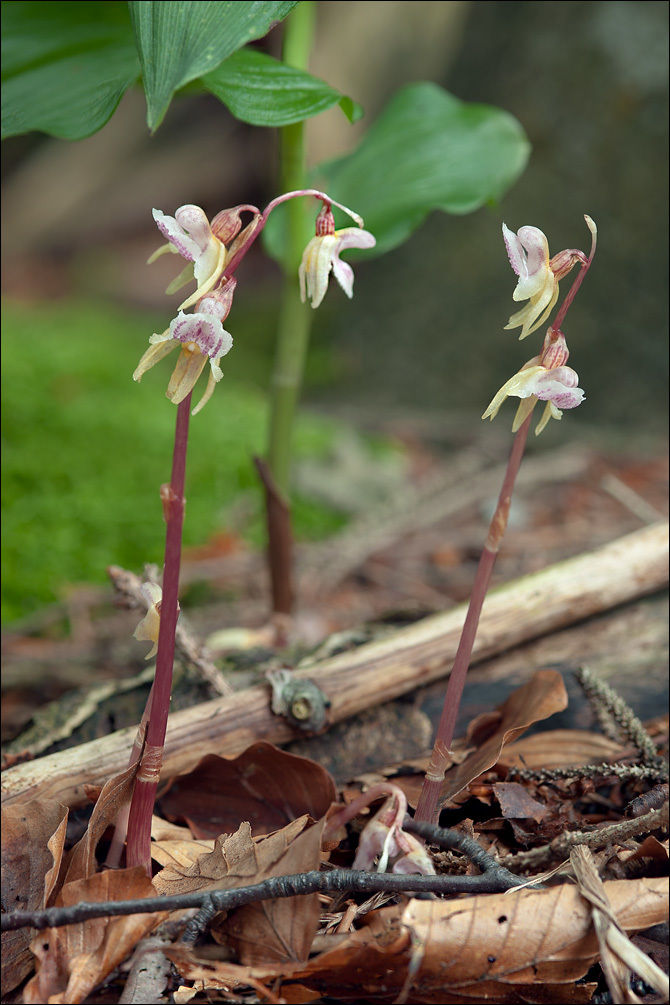
Slo.: brezlistni nadbradec - syn.: Satyrium epipogium L. - Habitat: steep mountain slope, southwest aspect, mixed Fagus sylvatica and Picea abies wood, under beeches; associated with Yellow bird's-nest (Hypopitys monotropa), Yellow coralroot (Corallorhiza trifida), Red Helleborine (Cephalanthera rubra) and Broad-leaved helleborine (Epipactis helleborine aggr), in shade, calcareous ground, on places with little or no ground vegetation, partly protected from direct rain by tree canopies, average precipitations ~3.000 mm/year, average temperature 2-4 deg C, elevation approximately 1.200 m (4.000 feet), alpine phytogeographical region. - Substratum: loose hummus soil. - Comment: It is always a happy event to see this legendary rare, mysterious and highly endangered wild orchid. This is particularly so, because even if one knows exactly where and when to search for it, it doesn't appear every year. Sometimes, searching can be of no avail for several consecutive years. I've been following its occurrence at these two sites for eight years now. The best blooming occurred in 2008 and much weaker in 2011. Next years there was nothing to see. In 2015 I found 16 plants in bloom and in this year there were about the same number at the first spot and only a single plant on the second spot. However, several have just protruded the ground surface and it seems possible that some more will appear in the next days.This achlorophyllous (having no chlorophyll), mycoheterotrophic (getting at least some part of its food from parasitism upon fungi) (not saprophytes! as frequently stated, see: Ref.:8), Euro-Asiatic plant, mostly living underground, has disappeared already from many places in Europe. O. Sebald et al. (1998) reports about a place in Baden-Wrttemberg, DE, which has been occasionally monitoring now for almost 80 years. Sources from 1935 talk about 'thousands of blooming plants'. The place was extensively studied again in 1996. Population found counted only 18 blooming plants. Drawings of the plants from 1935 show large groups of plants with up to 15 flowers per stem. In 1996 ten of 18 plants found had only a single flower and the highest number of flowers found was three - on a single plant. The main reason for this drastic decline seems to be nitrogenized soil through polluted air. Obviously no local protection means can help against polluted air.Protected by Uredba o zavarovanih prosto iveih rastlinskih vrstah, poglavje A, Uradni list RS, t. 46/2004 (Regulation of protected wild plants, chapter A, Official Gazette of Republic Slovenia, no. 46/2004), (2004). Pravilnik o uvrstitvi ogroenih rastlinskih in ivalskih vrst v rdei seznam, Uradni list RS, t. 82/2002 (Regulation of enlisting of endangered plant and animal species onto Red List, Official Gazette of Republic Slovenia, no. 82/2002) (2002) marked by 'E' representing a critically endangered species.Ref.:(1) M.A. Fischer, W. Adler, K. Oswald, Exkursionsflora fr sterreich, Liechtenstein und Sdtirol, LO Landesmuseen, Linz, Austria (2005), p 1049.(2) B.Dolinar, Kukavievke v Sloveniji (Orchidaceae of Slovenia) (in Slovenian), Pipinova Knjiga, (2015), p 85.(3) A.Martini et all., Mala Flora Slovenije, Tehnina Zaloba Slovenije (2007) (in Slovene), p 668. (4) O. Sebald, S. Seybold, G. Philippi, A. Werz, Die Farn- und Bltenpflanzen Baden-Wrttembergs, Ulmer, Band 8. (1998), p 318.(5) H. Baumann, S. Kuenkele, R.Lorenz, Orchideen Europas, Ulmer (2006), p 100.(6) H. Kretzschmar, Die Orchideen Deutschlands und angrenzenden Lander, Quelle Meyer (2008), p 144.(7) http://www.ncbi.nlm.nih.gov/pmc/articles/PMC2720653/ (8) http://www.kaowarsom.be/documents/B_59_2013/MERCKX.pdf
-
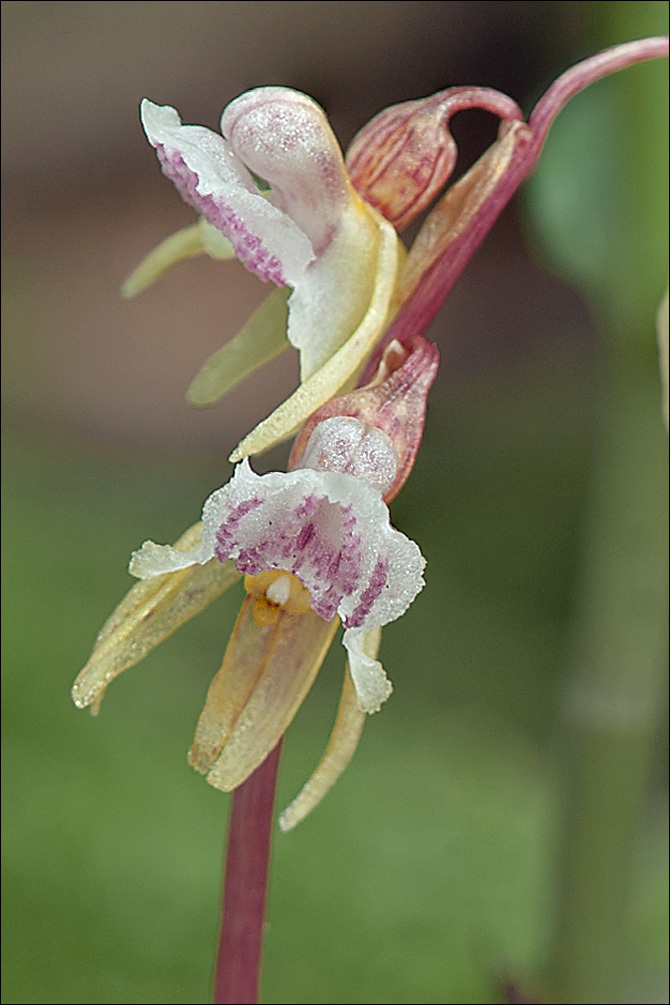
Slo.: brezlistni nadbradec - syn.: Satyrium epipogium L. - Coordinates intentionally not precize. - Habitat: steep mountain slope, southwest aspect, mixed Fagus sylvatica and Picea abies wood, under beeches; associated with Yellow bird's-nest (Hypopitys monotropa), Yellow coralroot (Corallorhiza trifida), Red Helleborine (Cephalanthera rubra) and Broad-leaved helleborine (Epipactis helleborine aggr), in shade, calcareous ground, on places with little or no ground vegetation, partly protected from direct rain by tree canopies, average precipitations ~3.000 mm/year, average temperature 2-4 deg C, elevation approximately 1.200 m (4.000 feet), alpine phytogeographical region. - Substratum: loose hummus soil. - Comment: It is always a happy event to see this legendary rare, mysterious and highly endangered wild orchid. This is particularly so, because even if one knows exactly where and when to search for it, it doesn't appear every year. Sometimes, searching can be of no avail for several consecutive years. I've been following its occurrence at these two sites for eight years now. The best blooming occurred in 2008 and much weaker in 2011. Next years there was nothing to see. In 2015 I found 16 plants in bloom and in this year there were about the same number at the first spot and only a single plant on the second spot. However, several have just protruded the ground surface and it seems possible that some more will appear in the next days. This achlorophyllous (having no chlorophyll), mycoheterotrophic (getting at least some part of its food from parasitism upon fungi) (not saprophytes! as frequently stated, see: Ref.:8), Euro-Asiatic plant, mostly living underground, has disappeared already from many places in Europe. O. Sebald et al. (1998) reports about a place in Baden-Wrttemberg, DE, which has been occasionally monitoring now for almost 80 years. Sources from 1935 talk about 'thousands of blooming plants'. The place was extensively studied again in 1996. Population found counted only 18 blooming plants. Drawings of the plants from 1935 show large groups of plants with up to 15 flowers per stem. In 1996 ten of 18 plants found had only a single flower and the highest number of flowers found was three - on a single plant. The main reason for this drastic decline seems to be nitrogenized soil through polluted air. Obviously no local protection means can help against polluted air. Protected by Uredba o zavarovanih prosto iveih rastlinskih vrstah, poglavje A, Uradni list RS, t. 46/2004 (Regulation of protected wild plants, chapter A, Official Gazette of Republic Slovenia, no. 46/2004), (2004). Pravilnik o uvrstitvi ogroenih rastlinskih in ivalskih vrst v rdei seznam, Uradni list RS, t. 82/2002 (Regulation of enlisting of endangered plant and animal species onto Red List, Official Gazette of Republic Slovenia, no. 82/2002) (2002) marked by 'E' representing a critically endangered species. Ref.: (1) M.A. Fischer, W. Adler, K. Oswald, Exkursionsflora fr sterreich, Liechtenstein und Sdtirol, LO Landesmuseen, Linz, Austria (2005), p 1049. (2) B.Dolinar, Kukavievke v Sloveniji (Orchidaceae of Slovenia) (in Slovenian), Pipinova Knjiga, (2015), p 85. (3) A.Martini et all., Mala Flora Slovenije, Tehnina Zaloba Slovenije (2007) (in Slovene), p 668. (4) O. Sebald, S. Seybold, G. Philippi, A. Werz, Die Farn- und Bltenpflanzen Baden-Wrttembergs, Ulmer, Band 8. (1998), p 318. (5) H. Baumann, S. Kuenkele, R.Lorenz, Orchideen Europas, Ulmer (2006), p 100. (6) H. Kretzschmar, Die Orchideen Deutschlands und angrenzenden Lander, Quelle Meyer (2008), p 144. (7) http://www.ncbi.nlm.nih.gov/pmc/articles/PMC2720653/ (8) http://www.kaowarsom.be/documents/B_59_2013/MERCKX.pdf
-
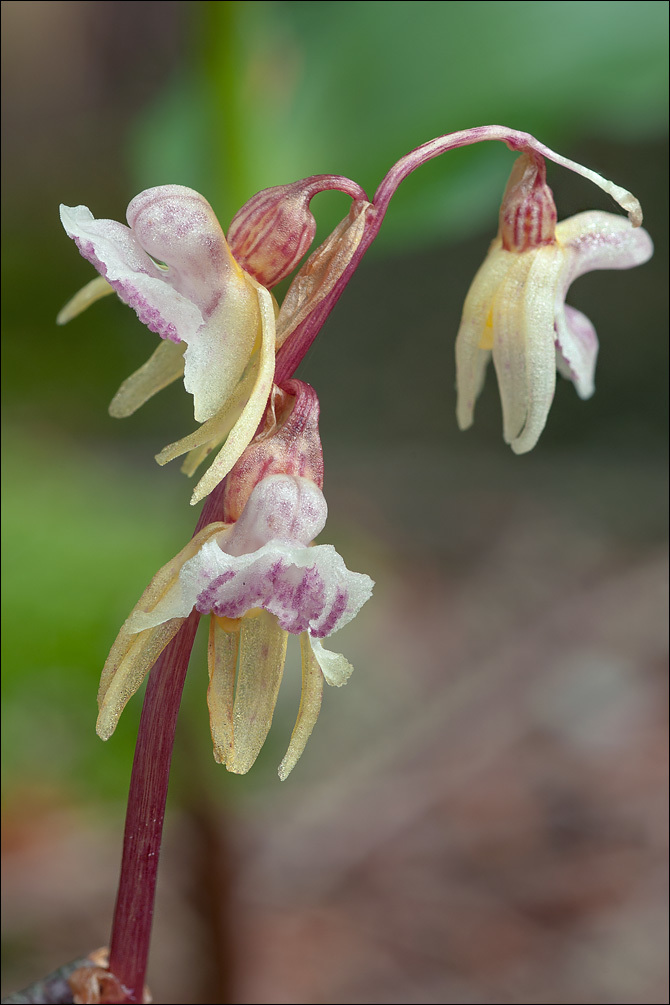
Slo.: brezlistni nadbradec - syn.: Satyrium epipogium L. - Coordinates intentionally not precize. - Habitat: steep mountain slope, southwest aspect, mixed Fagus sylvatica and Picea abies wood, under beeches; associated with Yellow bird's-nest (Hypopitys monotropa), Yellow coralroot (Corallorhiza trifida), Red Helleborine (Cephalanthera rubra) and Broad-leaved helleborine (Epipactis helleborine aggr), in shade, calcareous ground, on places with little or no ground vegetation, partly protected from direct rain by tree canopies, average precipitations ~3.000 mm/year, average temperature 2-4 deg C, elevation approximately 1.200 m (4.000 feet), alpine phytogeographical region. - Substratum: loose hummus soil. - Comment: It is always a happy event to see this legendary rare, mysterious and highly endangered wild orchid. This is particularly so, because even if one knows exactly where and when to search for it, it doesn't appear every year. Sometimes, searching can be of no avail for several consecutive years. I've been following its occurrence at these two sites for eight years now. The best blooming occurred in 2008 and much weaker in 2011. Next years there was nothing to see. In 2015 I found 16 plants in bloom and in this year there were about the same number at the first spot and only a single plant on the second spot. However, several have just protruded the ground surface and it seems possible that some more will appear in the next days. This achlorophyllous (having no chlorophyll), mycoheterotrophic (getting at least some part of its food from parasitism upon fungi) (not saprophytes! as frequently stated, see: Ref.:8), Euro-Asiatic plant, mostly living underground, has disappeared already from many places in Europe. O. Sebald et al. (1998) reports about a place in Baden-Wrttemberg, DE, which has been occasionally monitoring now for almost 80 years. Sources from 1935 talk about 'thousands of blooming plants'. The place was extensively studied again in 1996. Population found counted only 18 blooming plants. Drawings of the plants from 1935 show large groups of plants with up to 15 flowers per stem. In 1996 ten of 18 plants found had only a single flower and the highest number of flowers found was three - on a single plant. The main reason for this drastic decline seems to be nitrogenized soil through polluted air. Obviously no local protection means can help against polluted air. Protected by Uredba o zavarovanih prosto iveih rastlinskih vrstah, poglavje A, Uradni list RS, t. 46/2004 (Regulation of protected wild plants, chapter A, Official Gazette of Republic Slovenia, no. 46/2004), (2004). Pravilnik o uvrstitvi ogroenih rastlinskih in ivalskih vrst v rdei seznam, Uradni list RS, t. 82/2002 (Regulation of enlisting of endangered plant and animal species onto Red List, Official Gazette of Republic Slovenia, no. 82/2002) (2002) marked by 'E' representing a critically endangered species. Ref.: (1) M.A. Fischer, W. Adler, K. Oswald, Exkursionsflora fr sterreich, Liechtenstein und Sdtirol, LO Landesmuseen, Linz, Austria (2005), p 1049. (2) B.Dolinar, Kukavievke v Sloveniji (Orchidaceae of Slovenia) (in Slovenian), Pipinova Knjiga, (2015), p 85. (3) A.Martini et all., Mala Flora Slovenije, Tehnina Zaloba Slovenije (2007) (in Slovene), p 668. (4) O. Sebald, S. Seybold, G. Philippi, A. Werz, Die Farn- und Bltenpflanzen Baden-Wrttembergs, Ulmer, Band 8. (1998), p 318. (5) H. Baumann, S. Kuenkele, R.Lorenz, Orchideen Europas, Ulmer (2006), p 100. (6) H. Kretzschmar, Die Orchideen Deutschlands und angrenzenden Lander, Quelle Meyer (2008), p 144. (7) http://www.ncbi.nlm.nih.gov/pmc/articles/PMC2720653/ (8) http://www.kaowarsom.be/documents/B_59_2013/MERCKX.pdf
-
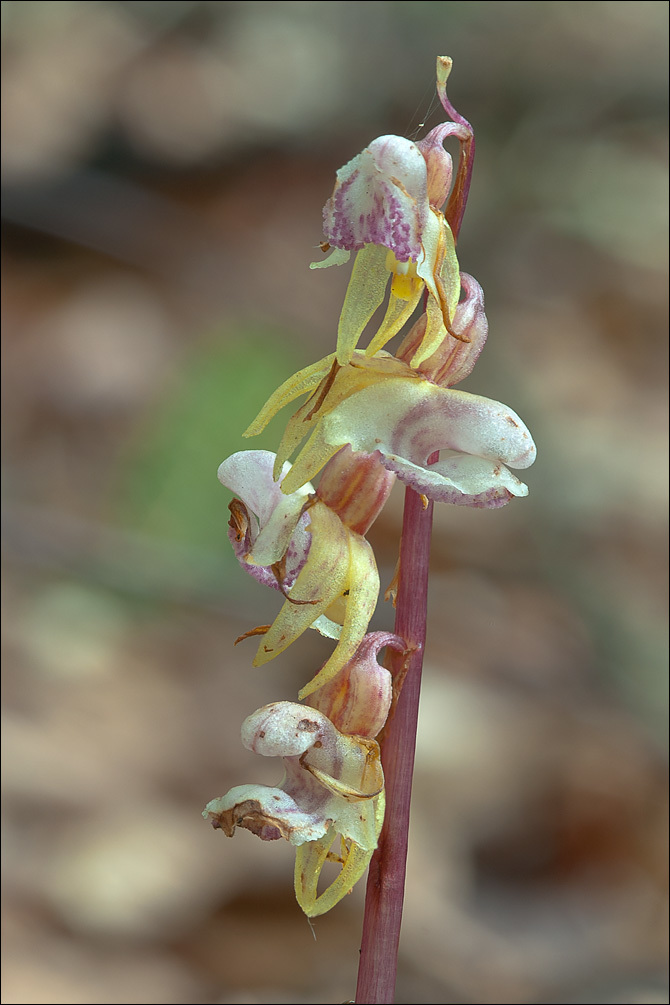
Slo.: brezlistni nadbradec - syn.: Satyrium epipogium L. - Coordinates intentionally not precize. - Habitat: steep mountain slope, southwest aspect, mixed Fagus sylvatica and Picea abies wood, under beeches; associated with Yellow bird's-nest (Hypopitys monotropa), Yellow coralroot (Corallorhiza trifida), Red Helleborine (Cephalanthera rubra) and Broad-leaved helleborine (Epipactis helleborine aggr), in shade, calcareous ground, on places with little or no ground vegetation, partly protected from direct rain by tree canopies, average precipitations ~3.000 mm/year, average temperature 2-4 deg C, elevation approximately 1.200 m (4.000 feet), alpine phytogeographical region. - Substratum: loose hummus soil. - Comment: It is always a happy event to see this legendary rare, mysterious and highly endangered wild orchid. This is particularly so, because even if one knows exactly where and when to search for it, it doesn't appear every year. Sometimes, searching can be of no avail for several consecutive years. I've been following its occurrence at these two sites for eight years now. The best blooming occurred in 2008 and much weaker in 2011. Next years there was nothing to see. In 2015 I found 16 plants in bloom and in this year there were about the same number at the first spot and only a single plant on the second spot. However, several have just protruded the ground surface and it seems possible that some more will appear in the next days. This achlorophyllous (having no chlorophyll), mycoheterotrophic (getting at least some part of its food from parasitism upon fungi) (not saprophytes! as frequently stated, see: Ref.:8), Euro-Asiatic plant, mostly living underground, has disappeared already from many places in Europe. O. Sebald et al. (1998) reports about a place in Baden-Wrttemberg, DE, which has been occasionally monitoring now for almost 80 years. Sources from 1935 talk about 'thousands of blooming plants'. The place was extensively studied again in 1996. Population found counted only 18 blooming plants. Drawings of the plants from 1935 show large groups of plants with up to 15 flowers per stem. In 1996 ten of 18 plants found had only a single flower and the highest number of flowers found was three - on a single plant. The main reason for this drastic decline seems to be nitrogenized soil through polluted air. Obviously no local protection means can help against polluted air. Protected by Uredba o zavarovanih prosto iveih rastlinskih vrstah, poglavje A, Uradni list RS, t. 46/2004 (Regulation of protected wild plants, chapter A, Official Gazette of Republic Slovenia, no. 46/2004), (2004). Pravilnik o uvrstitvi ogroenih rastlinskih in ivalskih vrst v rdei seznam, Uradni list RS, t. 82/2002 (Regulation of enlisting of endangered plant and animal species onto Red List, Official Gazette of Republic Slovenia, no. 82/2002) (2002) marked by 'E' representing a critically endangered species. Ref.: (1) M.A. Fischer, W. Adler, K. Oswald, Exkursionsflora fr sterreich, Liechtenstein und Sdtirol, LO Landesmuseen, Linz, Austria (2005), p 1049. (2) B.Dolinar, Kukavievke v Sloveniji (Orchidaceae of Slovenia) (in Slovenian), Pipinova Knjiga, (2015), p 85. (3) A.Martini et all., Mala Flora Slovenije, Tehnina Zaloba Slovenije (2007) (in Slovene), p 668. (4) O. Sebald, S. Seybold, G. Philippi, A. Werz, Die Farn- und Bltenpflanzen Baden-Wrttembergs, Ulmer, Band 8. (1998), p 318. (5) H. Baumann, S. Kuenkele, R.Lorenz, Orchideen Europas, Ulmer (2006), p 100. (6) H. Kretzschmar, Die Orchideen Deutschlands und angrenzenden Lander, Quelle Meyer (2008), p 144. (7) http://www.ncbi.nlm.nih.gov/pmc/articles/PMC2720653/ (8) http://www.kaowarsom.be/documents/B_59_2013/MERCKX.pdf
-
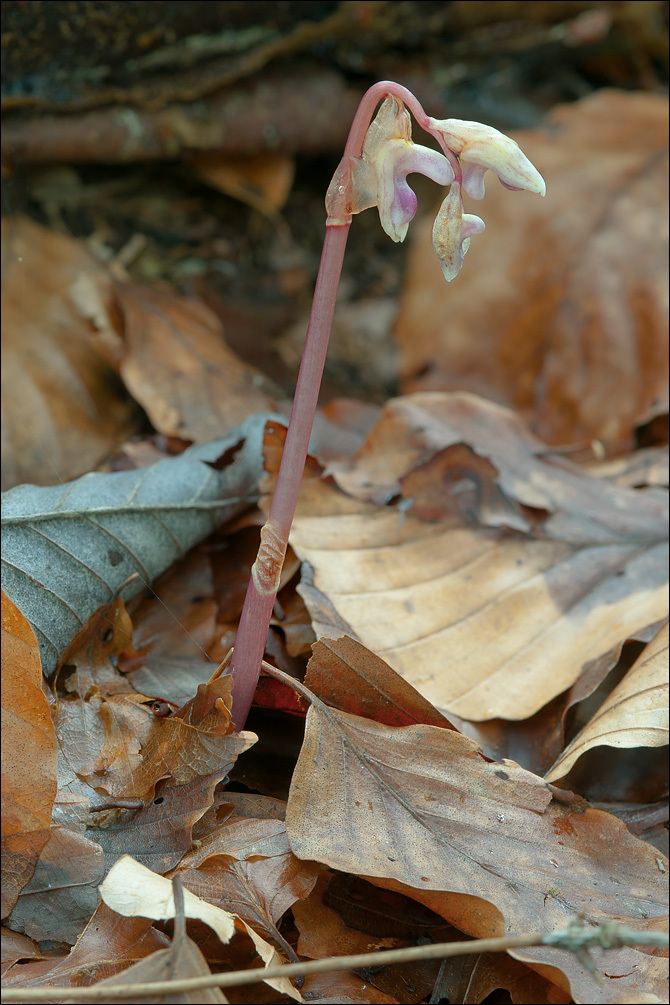
Slo.: brezlistni nadbradec - syn.: Satyrium epipogium L. - Coordinates intentionally not precize. - Habitat: steep mountain slope, southwest aspect, mixed Fagus sylvatica and Picea abies wood, under beeches; associated with Yellow bird's-nest (Hypopitys monotropa), Yellow coralroot (Corallorhiza trifida), Red Helleborine (Cephalanthera rubra) and Broad-leaved helleborine (Epipactis helleborine aggr), in shade, calcareous ground, on places with little or no ground vegetation, partly protected from direct rain by tree canopies, average precipitations ~3.000 mm/year, average temperature 2-4 deg C, elevation approximately 1.200 m (4.000 feet), alpine phytogeographical region. - Substratum: loose hummus soil. - Comment: It is always a happy event to see this legendary rare, mysterious and highly endangered wild orchid. This is particularly so, because even if one knows exactly where and when to search for it, it doesn't appear every year. Sometimes, searching can be of no avail for several consecutive years. I've been following its occurrence at these two sites for eight years now. The best blooming occurred in 2008 and much weaker in 2011. Next years there was nothing to see. In 2015 I found 16 plants in bloom and in this year there were about the same number at the first spot and only a single plant on the second spot. However, several have just protruded the ground surface and it seems possible that some more will appear in the next days. This achlorophyllous (having no chlorophyll), mycoheterotrophic (getting at least some part of its food from parasitism upon fungi) (not saprophytes! as frequently stated, see: Ref.:8), Euro-Asiatic plant, mostly living underground, has disappeared already from many places in Europe. O. Sebald et al. (1998) reports about a place in Baden-Wrttemberg, DE, which has been occasionally monitoring now for almost 80 years. Sources from 1935 talk about 'thousands of blooming plants'. The place was extensively studied again in 1996. Population found counted only 18 blooming plants. Drawings of the plants from 1935 show large groups of plants with up to 15 flowers per stem. In 1996 ten of 18 plants found had only a single flower and the highest number of flowers found was three - on a single plant. The main reason for this drastic decline seems to be nitrogenized soil through polluted air. Obviously no local protection means can help against polluted air. Protected by Uredba o zavarovanih prosto iveih rastlinskih vrstah, poglavje A, Uradni list RS, t. 46/2004 (Regulation of protected wild plants, chapter A, Official Gazette of Republic Slovenia, no. 46/2004), (2004). Pravilnik o uvrstitvi ogroenih rastlinskih in ivalskih vrst v rdei seznam, Uradni list RS, t. 82/2002 (Regulation of enlisting of endangered plant and animal species onto Red List, Official Gazette of Republic Slovenia, no. 82/2002) (2002) marked by 'E' representing a critically endangered species. Ref.: (1) M.A. Fischer, W. Adler, K. Oswald, Exkursionsflora fr sterreich, Liechtenstein und Sdtirol, LO Landesmuseen, Linz, Austria (2005), p 1049. (2) B.Dolinar, Kukavievke v Sloveniji (Orchidaceae of Slovenia) (in Slovenian), Pipinova Knjiga, (2015), p 85. (3) A.Martini et all., Mala Flora Slovenije, Tehnina Zaloba Slovenije (2007) (in Slovene), p 668. (4) O. Sebald, S. Seybold, G. Philippi, A. Werz, Die Farn- und Bltenpflanzen Baden-Wrttembergs, Ulmer, Band 8. (1998), p 318. (5) H. Baumann, S. Kuenkele, R.Lorenz, Orchideen Europas, Ulmer (2006), p 100. (6) H. Kretzschmar, Die Orchideen Deutschlands und angrenzenden Lander, Quelle Meyer (2008), p 144. (7) http://www.ncbi.nlm.nih.gov/pmc/articles/PMC2720653/ (8) http://www.kaowarsom.be/documents/B_59_2013/MERCKX.pdf
-
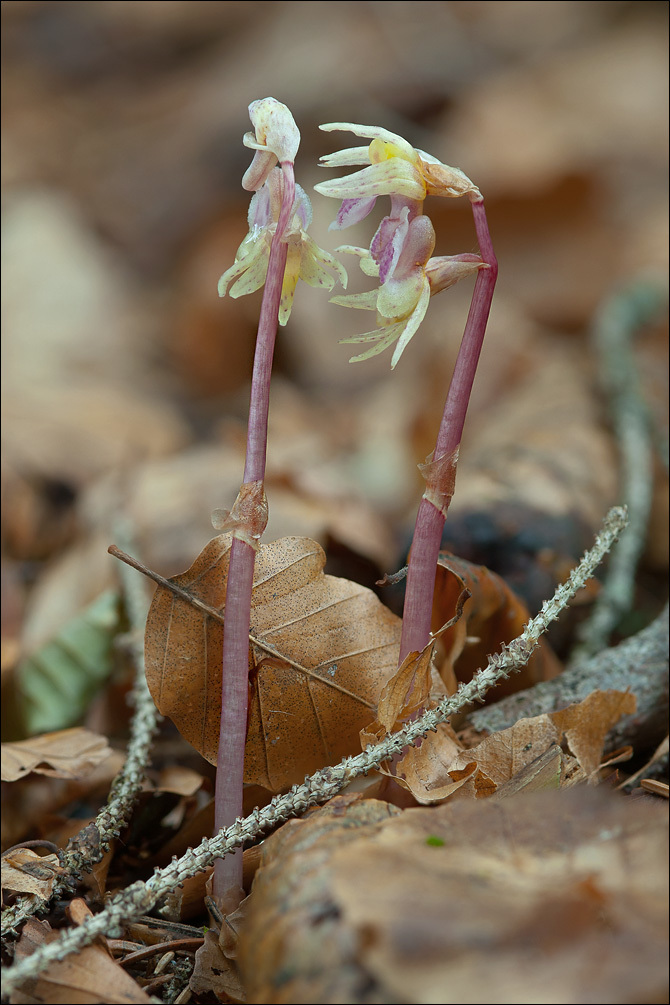
Slo.: brezlistni nadbradec - syn.: Satyrium epipogium L. - Coordinates intentionally not precize. - Habitat: steep mountain slope, southwest aspect, mixed Fagus sylvatica and Picea abies wood, under beeches; associated with Yellow bird's-nest (Hypopitys monotropa), Yellow coralroot (Corallorhiza trifida), Red Helleborine (Cephalanthera rubra) and Broad-leaved helleborine (Epipactis helleborine aggr), in shade, calcareous ground, on places with little or no ground vegetation, partly protected from direct rain by tree canopies, average precipitations ~3.000 mm/year, average temperature 2-4 deg C, elevation approximately 1.200 m (4.000 feet), alpine phytogeographical region. - Substratum: loose hummus soil. - Comment: It is always a happy event to see this legendary rare, mysterious and highly endangered wild orchid. This is particularly so, because even if one knows exactly where and when to search for it, it doesn't appear every year. Sometimes, searching can be of no avail for several consecutive years. I've been following its occurrence at these two sites for eight years now. The best blooming occurred in 2008 and much weaker in 2011. Next years there was nothing to see. In 2015 I found 16 plants in bloom and in this year there were about the same number at the first spot and only a single plant on the second spot. However, several have just protruded the ground surface and it seems possible that some more will appear in the next days. This achlorophyllous (having no chlorophyll), mycoheterotrophic (getting at least some part of its food from parasitism upon fungi) (not saprophytes! as frequently stated, see: Ref.:8), Euro-Asiatic plant, mostly living underground, has disappeared already from many places in Europe. O. Sebald et al. (1998) reports about a place in Baden-Wrttemberg, DE, which has been occasionally monitoring now for almost 80 years. Sources from 1935 talk about 'thousands of blooming plants'. The place was extensively studied again in 1996. Population found counted only 18 blooming plants. Drawings of the plants from 1935 show large groups of plants with up to 15 flowers per stem. In 1996 ten of 18 plants found had only a single flower and the highest number of flowers found was three - on a single plant. The main reason for this drastic decline seems to be nitrogenized soil through polluted air. Obviously no local protection means can help against polluted air. Protected by Uredba o zavarovanih prosto iveih rastlinskih vrstah, poglavje A, Uradni list RS, t. 46/2004 (Regulation of protected wild plants, chapter A, Official Gazette of Republic Slovenia, no. 46/2004), (2004). Pravilnik o uvrstitvi ogroenih rastlinskih in ivalskih vrst v rdei seznam, Uradni list RS, t. 82/2002 (Regulation of enlisting of endangered plant and animal species onto Red List, Official Gazette of Republic Slovenia, no. 82/2002) (2002) marked by 'E' representing a critically endangered species. Ref.: (1) M.A. Fischer, W. Adler, K. Oswald, Exkursionsflora fr sterreich, Liechtenstein und Sdtirol, LO Landesmuseen, Linz, Austria (2005), p 1049. (2) B.Dolinar, Kukavievke v Sloveniji (Orchidaceae of Slovenia) (in Slovenian), Pipinova Knjiga, (2015), p 85. (3) A.Martini et all., Mala Flora Slovenije, Tehnina Zaloba Slovenije (2007) (in Slovene), p 668. (4) O. Sebald, S. Seybold, G. Philippi, A. Werz, Die Farn- und Bltenpflanzen Baden-Wrttembergs, Ulmer, Band 8. (1998), p 318. (5) H. Baumann, S. Kuenkele, R.Lorenz, Orchideen Europas, Ulmer (2006), p 100. (6) H. Kretzschmar, Die Orchideen Deutschlands und angrenzenden Lander, Quelle Meyer (2008), p 144. (7) http://www.ncbi.nlm.nih.gov/pmc/articles/PMC2720653/ (8) http://www.kaowarsom.be/documents/B_59_2013/MERCKX.pdf
-
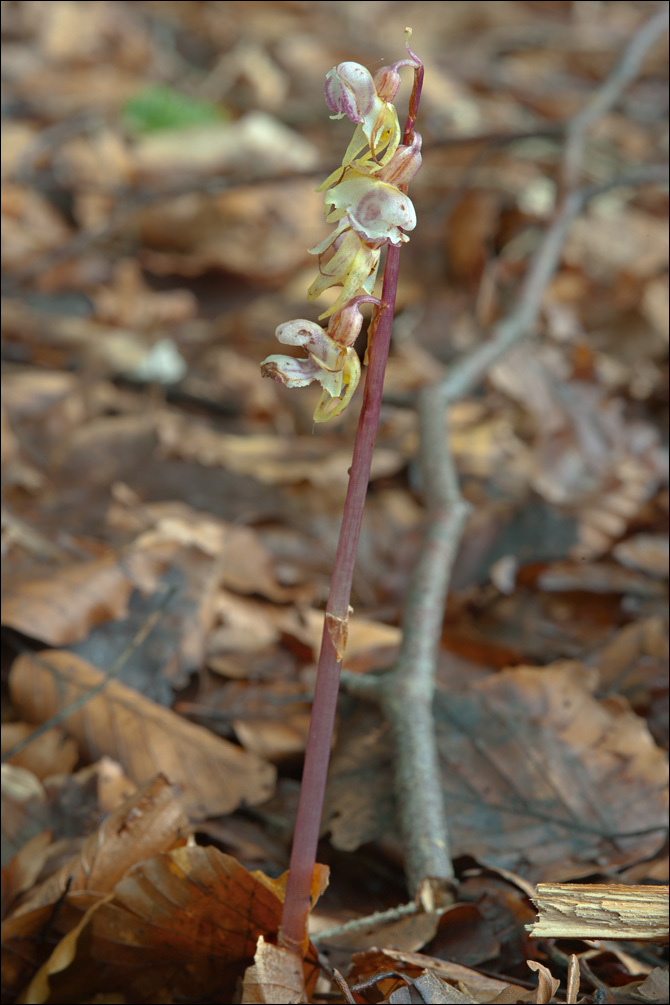
Slo.: brezlistni nadbradec - syn.: Satyrium epipogium L. - Coordinates intentionally not precize. - Habitat: steep mountain slope, southwest aspect, mixed Fagus sylvatica and Picea abies wood, under beeches; associated with Yellow bird's-nest (Hypopitys monotropa), Yellow coralroot (Corallorhiza trifida), Red Helleborine (Cephalanthera rubra) and Broad-leaved helleborine (Epipactis helleborine aggr), in shade, calcareous ground, on places with little or no ground vegetation, partly protected from direct rain by tree canopies, average precipitations ~3.000 mm/year, average temperature 2-4 deg C, elevation approximately 1.200 m (4.000 feet), alpine phytogeographical region. - Substratum: loose hummus soil. - Comment: It is always a happy event to see this legendary rare, mysterious and highly endangered wild orchid. This is particularly so, because even if one knows exactly where and when to search for it, it doesn't appear every year. Sometimes, searching can be of no avail for several consecutive years. I've been following its occurrence at these two sites for eight years now. The best blooming occurred in 2008 and much weaker in 2011. Next years there was nothing to see. In 2015 I found 16 plants in bloom and in this year there were about the same number at the first spot and only a single plant on the second spot. However, several have just protruded the ground surface and it seems possible that some more will appear in the next days. This achlorophyllous (having no chlorophyll), mycoheterotrophic (getting at least some part of its food from parasitism upon fungi) (not saprophytes! as frequently stated, see: Ref.:8), Euro-Asiatic plant, mostly living underground, has disappeared already from many places in Europe. O. Sebald et al. (1998) reports about a place in Baden-Wrttemberg, DE, which has been occasionally monitoring now for almost 80 years. Sources from 1935 talk about 'thousands of blooming plants'. The place was extensively studied again in 1996. Population found counted only 18 blooming plants. Drawings of the plants from 1935 show large groups of plants with up to 15 flowers per stem. In 1996 ten of 18 plants found had only a single flower and the highest number of flowers found was three - on a single plant. The main reason for this drastic decline seems to be nitrogenized soil through polluted air. Obviously no local protection means can help against polluted air. Protected by Uredba o zavarovanih prosto iveih rastlinskih vrstah, poglavje A, Uradni list RS, t. 46/2004 (Regulation of protected wild plants, chapter A, Official Gazette of Republic Slovenia, no. 46/2004), (2004). Pravilnik o uvrstitvi ogroenih rastlinskih in ivalskih vrst v rdei seznam, Uradni list RS, t. 82/2002 (Regulation of enlisting of endangered plant and animal species onto Red List, Official Gazette of Republic Slovenia, no. 82/2002) (2002) marked by 'E' representing a critically endangered species. Ref.: (1) M.A. Fischer, W. Adler, K. Oswald, Exkursionsflora fr sterreich, Liechtenstein und Sdtirol, LO Landesmuseen, Linz, Austria (2005), p 1049. (2) B.Dolinar, Kukavievke v Sloveniji (Orchidaceae of Slovenia) (in Slovenian), Pipinova Knjiga, (2015), p 85. (3) A.Martini et all., Mala Flora Slovenije, Tehnina Zaloba Slovenije (2007) (in Slovene), p 668. (4) O. Sebald, S. Seybold, G. Philippi, A. Werz, Die Farn- und Bltenpflanzen Baden-Wrttembergs, Ulmer, Band 8. (1998), p 318. (5) H. Baumann, S. Kuenkele, R.Lorenz, Orchideen Europas, Ulmer (2006), p 100. (6) H. Kretzschmar, Die Orchideen Deutschlands und angrenzenden Lander, Quelle Meyer (2008), p 144. (7) http://www.ncbi.nlm.nih.gov/pmc/articles/PMC2720653/ (8) http://www.kaowarsom.be/documents/B_59_2013/MERCKX.pdf
-
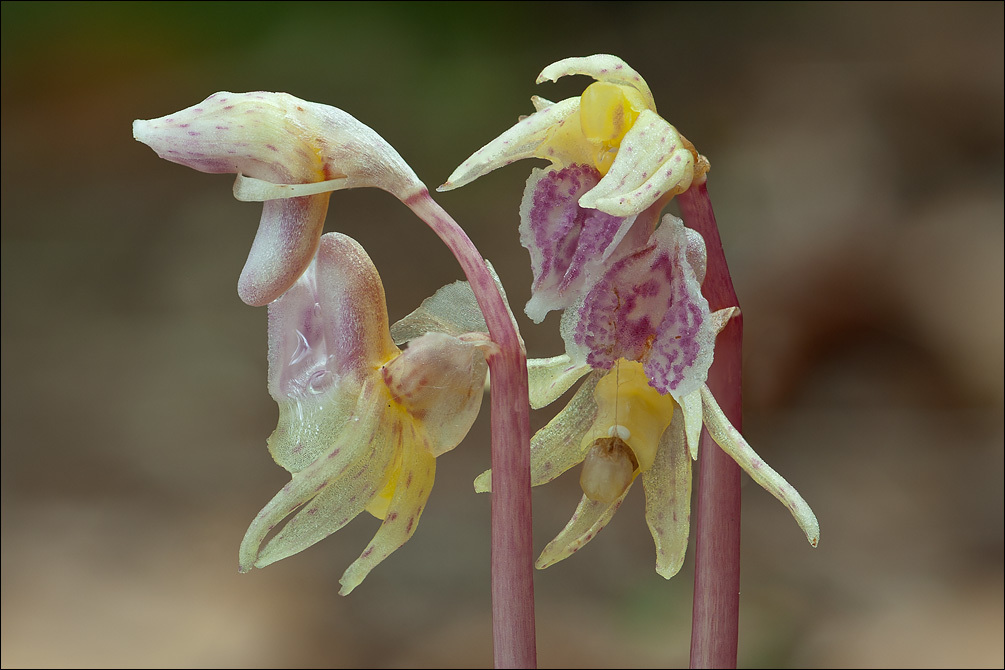
Slo.: brezlistni nadbradec - syn.: Satyrium epipogium L. - Coordinates intentionally not precize. - Habitat: steep mountain slope, southwest aspect, mixed Fagus sylvatica and Picea abies wood, under beeches; associated with Yellow bird's-nest (Hypopitys monotropa), Yellow coralroot (Corallorhiza trifida), Red Helleborine (Cephalanthera rubra) and Broad-leaved helleborine (Epipactis helleborine aggr), in shade, calcareous ground, on places with little or no ground vegetation, partly protected from direct rain by tree canopies, average precipitations ~3.000 mm/year, average temperature 2-4 deg C, elevation approximately 1.200 m (4.000 feet), alpine phytogeographical region. - Substratum: loose hummus soil. - Comment: It is always a happy event to see this legendary rare, mysterious and highly endangered wild orchid. This is particularly so, because even if one knows exactly where and when to search for it, it doesn't appear every year. Sometimes, searching can be of no avail for several consecutive years. I've been following its occurrence at these two sites for eight years now. The best blooming occurred in 2008 and much weaker in 2011. Next years there was nothing to see. In 2015 I found 16 plants in bloom and in this year there were about the same number at the first spot and only a single plant on the second spot. However, several have just protruded the ground surface and it seems possible that some more will appear in the next days. This achlorophyllous (having no chlorophyll), mycoheterotrophic (getting at least some part of its food from parasitism upon fungi) (not saprophytes! as frequently stated, see: Ref.:8), Euro-Asiatic plant, mostly living underground, has disappeared already from many places in Europe. O. Sebald et al. (1998) reports about a place in Baden-Wrttemberg, DE, which has been occasionally monitoring now for almost 80 years. Sources from 1935 talk about 'thousands of blooming plants'. The place was extensively studied again in 1996. Population found counted only 18 blooming plants. Drawings of the plants from 1935 show large groups of plants with up to 15 flowers per stem. In 1996 ten of 18 plants found had only a single flower and the highest number of flowers found was three - on a single plant. The main reason for this drastic decline seems to be nitrogenized soil through polluted air. Obviously no local protection means can help against polluted air. Protected by Uredba o zavarovanih prosto iveih rastlinskih vrstah, poglavje A, Uradni list RS, t. 46/2004 (Regulation of protected wild plants, chapter A, Official Gazette of Republic Slovenia, no. 46/2004), (2004). Pravilnik o uvrstitvi ogroenih rastlinskih in ivalskih vrst v rdei seznam, Uradni list RS, t. 82/2002 (Regulation of enlisting of endangered plant and animal species onto Red List, Official Gazette of Republic Slovenia, no. 82/2002) (2002) marked by 'E' representing a critically endangered species. Ref.: (1) M.A. Fischer, W. Adler, K. Oswald, Exkursionsflora fr sterreich, Liechtenstein und Sdtirol, LO Landesmuseen, Linz, Austria (2005), p 1049. (2) B.Dolinar, Kukavievke v Sloveniji (Orchidaceae of Slovenia) (in Slovenian), Pipinova Knjiga, (2015), p 85. (3) A.Martini et all., Mala Flora Slovenije, Tehnina Zaloba Slovenije (2007) (in Slovene), p 668. (4) O. Sebald, S. Seybold, G. Philippi, A. Werz, Die Farn- und Bltenpflanzen Baden-Wrttembergs, Ulmer, Band 8. (1998), p 318. (5) H. Baumann, S. Kuenkele, R.Lorenz, Orchideen Europas, Ulmer (2006), p 100. (6) H. Kretzschmar, Die Orchideen Deutschlands und angrenzenden Lander, Quelle Meyer (2008), p 144. (7) http://www.ncbi.nlm.nih.gov/pmc/articles/PMC2720653/ (8) http://www.kaowarsom.be/documents/B_59_2013/MERCKX.pdf
-

Slo.: brezlistni nadbradec - syn.: Satyrium epipogium L. - Coordinates intentionally not precize. - Habitat: steep mountain slope, southwest aspect, mixed Fagus sylvatica and Picea abies wood, under beeches; associated with Yellow bird's-nest (Hypopitys monotropa), Yellow coralroot (Corallorhiza trifida), Red Helleborine (Cephalanthera rubra) and Broad-leaved helleborine (Epipactis helleborine aggr), in shade, calcareous ground, on places with little or no ground vegetation, partly protected from direct rain by tree canopies, average precipitations ~3.000 mm/year, average temperature 2-4 deg C, elevation approximately 1.200 m (4.000 feet), alpine phytogeographical region. - Substratum: loose hummus soil. - Comment: It is always a happy event to see this legendary rare, mysterious and highly endangered wild orchid. This is particularly so, because even if one knows exactly where and when to search for it, it doesn't appear every year. Sometimes, searching can be of no avail for several consecutive years. I've been following its occurrence at these two sites for eight years now. The best blooming occurred in 2008 and much weaker in 2011. Next years there was nothing to see. In 2015 I found 16 plants in bloom and in this year there were about the same number at the first spot and only a single plant on the second spot. However, several have just protruded the ground surface and it seems possible that some more will appear in the next days. This achlorophyllous (having no chlorophyll), mycoheterotrophic (getting at least some part of its food from parasitism upon fungi) (not saprophytes! as frequently stated, see: Ref.:8), Euro-Asiatic plant, mostly living underground, has disappeared already from many places in Europe. O. Sebald et al. (1998) reports about a place in Baden-Wrttemberg, DE, which has been occasionally monitoring now for almost 80 years. Sources from 1935 talk about 'thousands of blooming plants'. The place was extensively studied again in 1996. Population found counted only 18 blooming plants. Drawings of the plants from 1935 show large groups of plants with up to 15 flowers per stem. In 1996 ten of 18 plants found had only a single flower and the highest number of flowers found was three - on a single plant. The main reason for this drastic decline seems to be nitrogenized soil through polluted air. Obviously no local protection means can help against polluted air. Protected by Uredba o zavarovanih prosto iveih rastlinskih vrstah, poglavje A, Uradni list RS, t. 46/2004 (Regulation of protected wild plants, chapter A, Official Gazette of Republic Slovenia, no. 46/2004), (2004). Pravilnik o uvrstitvi ogroenih rastlinskih in ivalskih vrst v rdei seznam, Uradni list RS, t. 82/2002 (Regulation of enlisting of endangered plant and animal species onto Red List, Official Gazette of Republic Slovenia, no. 82/2002) (2002) marked by 'E' representing a critically endangered species. Ref.: (1) M.A. Fischer, W. Adler, K. Oswald, Exkursionsflora fr sterreich, Liechtenstein und Sdtirol, LO Landesmuseen, Linz, Austria (2005), p 1049. (2) B.Dolinar, Kukavievke v Sloveniji (Orchidaceae of Slovenia) (in Slovenian), Pipinova Knjiga, (2015), p 85. (3) A.Martini et all., Mala Flora Slovenije, Tehnina Zaloba Slovenije (2007) (in Slovene), p 668. (4) O. Sebald, S. Seybold, G. Philippi, A. Werz, Die Farn- und Bltenpflanzen Baden-Wrttembergs, Ulmer, Band 8. (1998), p 318. (5) H. Baumann, S. Kuenkele, R.Lorenz, Orchideen Europas, Ulmer (2006), p 100. (6) H. Kretzschmar, Die Orchideen Deutschlands und angrenzenden Lander, Quelle Meyer (2008), p 144. (7) http://www.ncbi.nlm.nih.gov/pmc/articles/PMC2720653/ (8) http://www.kaowarsom.be/documents/B_59_2013/MERCKX.pdf
-
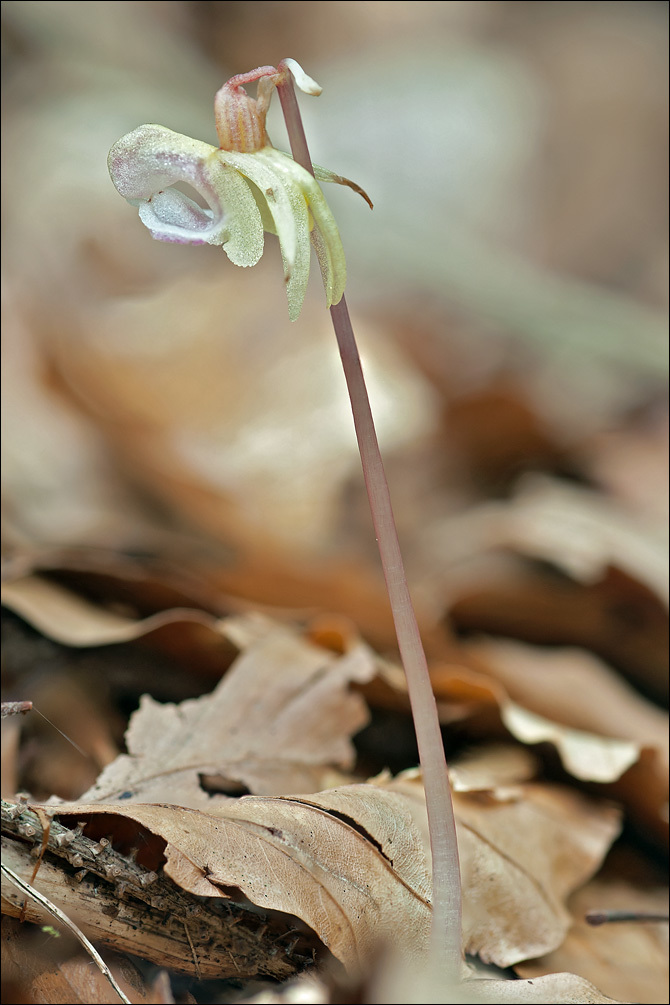
Slo.: brezlistni nadbradec - syn.: Satyrium epipogium L. - Coordinates intentionally not precize. - Habitat: moderately steep mountain slope, south aspect, mixed Fagus sylvatica and Picea abies wood, under small, young beeches among old Picea abies trees; associated with Yellow bird's-nest (Hypopitys monotropa), Yellow coralroot (Corallorhiza trifida) and Red Helleborine (Cephalanthera rubra), in deep shade, calcareous ground, on places with almost no ground vegetation, partly protected from direct rain by tree canopies, average precipitations ~3.000 mm/year, average temperature 2-4 deg C, elevation approximately 1.250 m (4.000 feet), alpine phytogeographical region. - Substratum: loose hummus soil. - Comment: It is always a happy event to see this legendary rare, mysterious and highly endangered wild orchid. This is particularly so, because even if one knows exactly where and when to search for it, it doesn't appear every year. Sometimes, searching can be of no avail for several consecutive years. I've been following its occurrence at these two sites for eight years now. The best blooming occurred in 2008 and much weaker in 2011. Next years there was nothing to see. In 2015 I found 16 plants in bloom and in this year there were about the same number at the first spot and only a single plant on the second spot. However, several have just protruded the ground surface and it seems possible that some more will appear in the next days. This achlorophyllous (having no chlorophyll), mycoheterotrophic (getting at least some part of its food from parasitism upon fungi) (not saprophytes! as frequently stated, see: Ref.:8), Euro-Asiatic plant, mostly living underground, has disappeared already from many places in Europe. O. Sebald et al. (1998) reports about a place in Baden-Wrttemberg, DE, which has been occasionally monitoring now for almost 80 years. Sources from 1935 talk about 'thousands of blooming plants'. The place was extensively studied again in 1996. Population found counted only 18 blooming plants. Drawings of the plants from 1935 show large groups of plants with up to 15 flowers per stem. In 1996 ten of 18 plants found had only a single flower and the highest number of flowers found was three - on a single plant. The main reason for this drastic decline seems to be nitrogenized soil through polluted air. Obviously no local protection means can help against polluted air. Protected by Uredba o zavarovanih prosto iveih rastlinskih vrstah, poglavje A, Uradni list RS, t. 46/2004 (Regulation of protected wild plants, chapter A, Official Gazette of Republic Slovenia, no. 46/2004), (2004). Pravilnik o uvrstitvi ogroenih rastlinskih in ivalskih vrst v rdei seznam, Uradni list RS, t. 82/2002 (Regulation of enlisting of endangered plant and animal species onto Red List, Official Gazette of Republic Slovenia, no. 82/2002) (2002) marked by 'E' representing a critically endangered species. Ref.: (1) M.A. Fischer, W. Adler, K. Oswald, Exkursionsflora fr sterreich, Liechtenstein und Sdtirol, LO Landesmuseen, Linz, Austria (2005), p 1049. (2) B.Dolinar, Kukavievke v Sloveniji (Orchidaceae of Slovenia) (in Slovenian), Pipinova Knjiga, (2015), p 85. (3) A.Martini et all., Mala Flora Slovenije, Tehnina Zaloba Slovenije (2007) (in Slovene), p 668. (4) O. Sebald, S. Seybold, G. Philippi, A. Werz, Die Farn- und Bltenpflanzen Baden-Wrttembergs, Ulmer, Band 8. (1998), p 318. (5) H. Baumann, S. Kuenkele, R.Lorenz, Orchideen Europas, Ulmer (2006), p 100. (6) H. Kretzschmar, Die Orchideen Deutschlands und angrenzenden Lander, Quelle Meyer (2008), p 144. (7) http://www.ncbi.nlm.nih.gov/pmc/articles/PMC2720653/ (8) http://www.kaowarsom.be/documents/B_59_2013/MERCKX.pdf
-
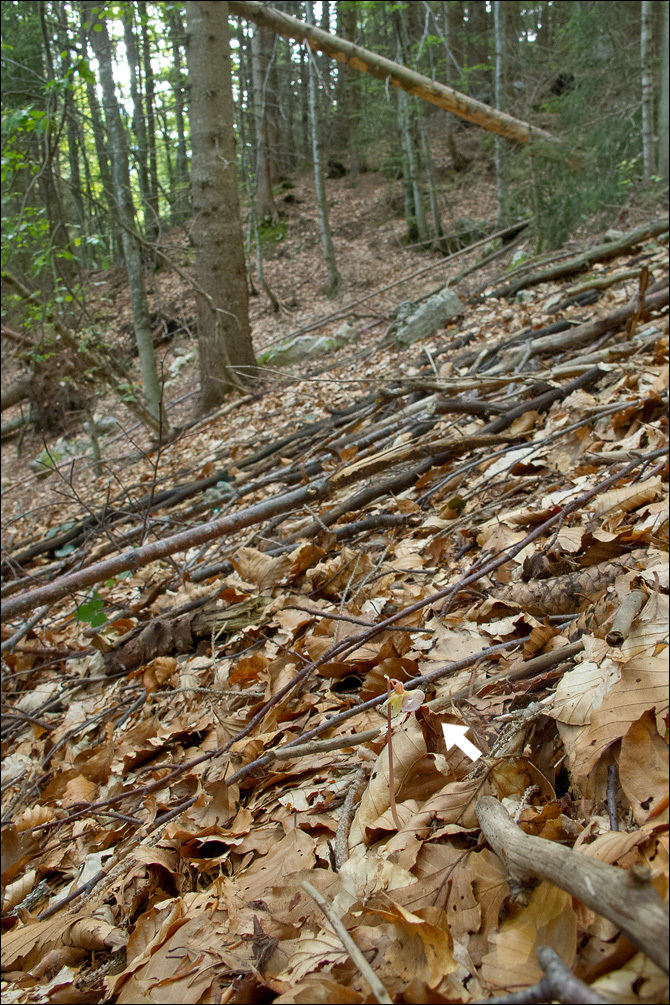
Slo.: brezlistni nadbradec - syn.: Satyrium epipogium L. - Coordinates intentionally not precize. - Habitat: moderately steep mountain slope, south aspect, mixed Fagus sylvatica and Picea abies wood, under small, young beeches among old Picea abies trees; associated with Yellow bird's-nest (Hypopitys monotropa), Yellow coralroot (Corallorhiza trifida) and Red Helleborine (Cephalanthera rubra), in deep shade, calcareous ground, on places with almost no ground vegetation, partly protected from direct rain by tree canopies, average precipitations ~3.000 mm/year, average temperature 2-4 deg C, elevation approximately 1.250 m (4.000 feet), alpine phytogeographical region. - Substratum: loose hummus soil. - Comment: It is always a happy event to see this legendary rare, mysterious and highly endangered wild orchid. This is particularly so, because even if one knows exactly where and when to search for it, it doesn't appear every year. Sometimes, searching can be of no avail for several consecutive years. I've been following its occurrence at these two sites for eight years now. The best blooming occurred in 2008 and much weaker in 2011. Next years there was nothing to see. In 2015 I found 16 plants in bloom and in this year there were about the same number at the first spot and only a single plant on the second spot. However, several have just protruded the ground surface and it seems possible that some more will appear in the next days. This achlorophyllous (having no chlorophyll), mycoheterotrophic (getting at least some part of its food from parasitism upon fungi) (not saprophytes! as frequently stated, see: Ref.:8), Euro-Asiatic plant, mostly living underground, has disappeared already from many places in Europe. O. Sebald et al. (1998) reports about a place in Baden-Wrttemberg, DE, which has been occasionally monitoring now for almost 80 years. Sources from 1935 talk about 'thousands of blooming plants'. The place was extensively studied again in 1996. Population found counted only 18 blooming plants. Drawings of the plants from 1935 show large groups of plants with up to 15 flowers per stem. In 1996 ten of 18 plants found had only a single flower and the highest number of flowers found was three - on a single plant. The main reason for this drastic decline seems to be nitrogenized soil through polluted air. Obviously no local protection means can help against polluted air. Protected by Uredba o zavarovanih prosto iveih rastlinskih vrstah, poglavje A, Uradni list RS, t. 46/2004 (Regulation of protected wild plants, chapter A, Official Gazette of Republic Slovenia, no. 46/2004), (2004). Pravilnik o uvrstitvi ogroenih rastlinskih in ivalskih vrst v rdei seznam, Uradni list RS, t. 82/2002 (Regulation of enlisting of endangered plant and animal species onto Red List, Official Gazette of Republic Slovenia, no. 82/2002) (2002) marked by 'E' representing a critically endangered species. Ref.: (1) M.A. Fischer, W. Adler, K. Oswald, Exkursionsflora fr sterreich, Liechtenstein und Sdtirol, LO Landesmuseen, Linz, Austria (2005), p 1049. (2) B.Dolinar, Kukavievke v Sloveniji (Orchidaceae of Slovenia) (in Slovenian), Pipinova Knjiga, (2015), p 85. (3) A.Martini et all., Mala Flora Slovenije, Tehnina Zaloba Slovenije (2007) (in Slovene), p 668. (4) O. Sebald, S. Seybold, G. Philippi, A. Werz, Die Farn- und Bltenpflanzen Baden-Wrttembergs, Ulmer, Band 8. (1998), p 318. (5) H. Baumann, S. Kuenkele, R.Lorenz, Orchideen Europas, Ulmer (2006), p 100. (6) H. Kretzschmar, Die Orchideen Deutschlands und angrenzenden Lander, Quelle Meyer (2008), p 144. (7) http://www.ncbi.nlm.nih.gov/pmc/articles/PMC2720653/ (8) http://www.kaowarsom.be/documents/B_59_2013/MERCKX.pdf

